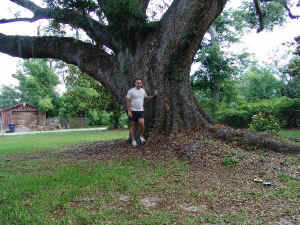| Gulfport
- Live Oak Project |
tuce-@msn.com |
| Jun
07, 2007 08:46 PDT |
ENTS,
Measured two more 20' plus Live Oaks in Gulfport yesterday.
Located at
1005 and 1008 Bridge St., Gulfport, Ms. The first tree, the new
#22 on
our listing, CBH-24'2", Spread-135' and Height-66'.
 |
 |
| The new #22 The Bridge St. Oak located at 1005 Bridge St., Gulfport, Ms. CBH-24’2”, Spread-135’ and Height-66’. |
The
second tree,
#36,CBH-20'4", Spread-105 and Height-58.5'.
My listing
now
contains 38 Measured Live Oaks 20' or greater CBH. The majority
coming
from Ms., Louisiana has thousands more, I will focus on those
soon. I
still haven't measured the Ms. State Champion Live Oak in Pearl
River
Co. I also wrote the Owners of the National Champion Live
Oak,(The Seven
Sisters Oak), for permission to remeasure it. In 2001 it was
38', maybe
in my Life, it will be 40'! Maybe not! The Ms. Gulf Coast has an
almost
continuous Live Oak Grove from Biloxi Bay, west to Bay St.
Louis, about
1 mile wide and 25 miles long. Making it possibly the Largest
Live Oak
Grove in the World.
Live Oak Leaves
I wonder how large the Live Oak Groves are
in
Georgia, Virginia and the Carolina's? Anybody.
Larry
|
| Back
to Larry |
dbhg-@comcast.net |
| Jun
07, 2007 11:41 PDT |
Larry,
I'm curious as to densities of the 20-footers.
How are they distributed? For example, would you expect to find
spots where there were 2 or more per say 100-acres area? For the
most part, are these loaners, i.e. one per property? Or when you
find one, is there a high probability of a second fairly close
by as in a cemetery. The sheer number of square miles of the
territory you are covering sounds like there is a possibility of
finding hundreds of 20-footers. Is that correct? In your
statement: "The majority coming from Ms., Louisiana has
thousands more, I will focus on those soon.", does the
"thousands more refer to the number of live oaks as a total
population? You didn't mean thousands of 20-footers, did you?
Bob
|
| RE:
Back to Bob |
tuce-@msn.com |
| Jun
07, 2007 12:56 PDT |
Bob,
As a total population, as for the distribution of large trees in
Ocean
Springs there were 3,20+ within 5 acres. Sometimes they are in
2's, but
for the most part they are singles. In a natural setting
undisturbed
there may have been hundreds or maybe thousands, I'm convinced I
could
locate at least,100 20'+ Live Oaks on the Ms. Gulf Coast. The
30'+ are
the rare ones.
|
| Back
to Larry Again |
dbhg-@comcast.net |
| Jun
08, 2007 10:14 PDT |
Larry
and Ed,
Perhaps ENTS should start a 30-ft
GBH club to shine the spotlight on the truly extraordinary big
girth trees. Historically, live oak, bald cypress, American
sycamore, American chestnut, and tuliptree would would make up
the bulk of the membership, perhaps in that order of frequency.
An occasional eastern cottonwood, white oak, willow, or tulepo
would have found its way into the group. Silver maple would come
close at times and maybe squeak in. But I doubt that there would
be any other eastern species in the club beyond token
representation. There is always room for a statistical outlier
for species like cherrybark oak, willow oak, etc. but I've read
nothing to suggest that those trees reached 30 feet in girth,
which represents a thickness of 9.55 feet.
For trees that split close to the
ground, either as a coppice from the original tree having been
cut or from some kind of natural damage, I would agree. We need
to have a separate category for them. The challenge is to
distinguish the fusion of what began and progressed as two
separate until lateral expansion forced a fusion of trunks. I've
become pretty adept at distinguishing fused white pines, but
species like sycamore can be "fusion confusion".
Bob
|
|